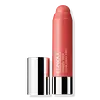What's inside
What's inside
 Key Ingredients
Key Ingredients

 Benefits
Benefits

 Concerns
Concerns

 Ingredients Side-by-side
Ingredients Side-by-side

Isodecyl Isononanoate
EmollientPolyethylene
AbrasivePropylene Glycol Dicaprylate/Dicaprate
EmollientHdi/Trimethylol Hexyllactone Crosspolymer
Euphorbia Cerifera Wax
Bis-Diglyceryl Polyacyladipate-2
EmollientDiisopropyl Dimer Dilinoleate
EmollientOzokerite
Emulsion StabilisingSqualane
EmollientCeresin
Emulsion StabilisingHydrogenated Polyisobutene
EmollientSilica
AbrasiveOctyldodecanol
EmollientPhytosteryl Isostearate
Skin ConditioningOryzanol
Skin ConditioningTocopheryl Acetate
AntioxidantLauroyl Lysine
Skin ConditioningLecithin
EmollientSynthetic Beeswax
Emulsion StabilisingLauryl PCA
HumectantCaprylyl Glycol
EmollientEthylene/Propylene/Styrene Copolymer
Propylene Carbonate
SolventDisteardimonium Hectorite
StabilisingTin Oxide
AbrasiveButylene/Ethylene/Styrene Copolymer
Alumina
AbrasiveSynthetic Fluorphlogopite
Mica
Cosmetic ColorantCI 77891
Cosmetic ColorantCI 77491
Cosmetic ColorantCI 77492
Cosmetic ColorantCI 77499
Cosmetic ColorantCI 15850
Cosmetic ColorantCI 19140
Cosmetic ColorantCI 42090
Cosmetic ColorantCI 75470
Cosmetic ColorantCI 77742
Cosmetic ColorantCI 77510
Cosmetic ColorantCI 45380
Cosmetic ColorantCI 73360
Cosmetic ColorantCI 77288
Cosmetic ColorantCI 77289
Cosmetic ColorantCI 77163
Cosmetic ColorantCI 77007
Cosmetic ColorantCI 17200
Cosmetic ColorantCI 45410
Cosmetic ColorantCI 15985
Cosmetic ColorantIsodecyl Isononanoate, Polyethylene, Propylene Glycol Dicaprylate/Dicaprate, Hdi/Trimethylol Hexyllactone Crosspolymer, Euphorbia Cerifera Wax, Bis-Diglyceryl Polyacyladipate-2, Diisopropyl Dimer Dilinoleate, Ozokerite, Squalane, Ceresin, Hydrogenated Polyisobutene, Silica, Octyldodecanol, Phytosteryl Isostearate, Oryzanol, Tocopheryl Acetate, Lauroyl Lysine, Lecithin, Synthetic Beeswax, Lauryl PCA, Caprylyl Glycol, Ethylene/Propylene/Styrene Copolymer, Propylene Carbonate, Disteardimonium Hectorite, Tin Oxide, Butylene/Ethylene/Styrene Copolymer, Alumina, Synthetic Fluorphlogopite, Mica, CI 77891, CI 77491, CI 77492, CI 77499, CI 15850, CI 19140, CI 42090, CI 75470, CI 77742, CI 77510, CI 45380, CI 73360, CI 77288, CI 77289, CI 77163, CI 77007, CI 17200, CI 45410, CI 15985
Isocetyl Stearoyl Stearate
EmollientGlycerin
HumectantTribehenin
EmollientSambucus Nigra Fruit Extract
AstringentMica
Cosmetic ColorantGlyceryl Stearate
EmollientGlycyrrhiza Glabra Root Extract
BleachingSilica
AbrasiveMorus Alba Root Extract
BleachingSymphytum Officinale Leaf Extract
Skin ConditioningOenothera Biennis Root Extract
Skin ConditioningTitanium Dioxide
Cosmetic ColorantCI 77891
Cosmetic ColorantIron Oxides
CI 15985
Cosmetic ColorantCI 15850
Cosmetic ColorantCI 45380
Cosmetic ColorantCI 77510
Cosmetic ColorantIsocetyl Stearoyl Stearate, Glycerin, Tribehenin, Sambucus Nigra Fruit Extract, Mica, Glyceryl Stearate, Glycyrrhiza Glabra Root Extract, Silica, Morus Alba Root Extract, Symphytum Officinale Leaf Extract, Oenothera Biennis Root Extract, Titanium Dioxide, CI 77891, Iron Oxides, CI 15985, CI 15850, CI 45380, CI 77510
 Reviews
Reviews

Alternatives
Ingredients Explained
These ingredients are found in both products.
Ingredients higher up in an ingredient list are typically present in a larger amount.
Ci 15850 is the pigment color red. It is an azo dye and created synthetically.
Azo dyes need to be thoroughly purified before use. This allows them to be more stable and longer-lasting.
This ingredient is common in foundations, lipsticks, and blushes. This color is described as brown/orangey red.
It has many secondary names such as Red 6 and Red 7. According to a manufacturer, Red 6 usually contains aluminum.
Learn more about CI 15850Ci 15985 is a dye made from petroleum. It is synthetically created and approved by the FDA for use in foods and cosmetics.
The color of this dye is orange/yellow.
This ingredient can be found in makeup, sun care, and skincare.
Learn more about CI 15985Ci 45380 is a synthetic dye that comes from coal or tar sources. Due to this, it is often used in small quantities.
A common name for this dye is Red 22. Red 22 imparts a warm reddish color.
Similar to Red 27, this dye changes color based on pH and moisture levels.
This dye is colorless when dry but turns pink between pH levels 0.0 to ~3.0.
Learn more about CI 45380This ingredient is used to impart a blue color. It is not water-soluble.
It goes by two different names:
1. Ferric Ferrocyanide: a synthetic dark blue pigment
2. Ferric Ammonium Ferrocyanide: a synthetic blue pigment, also called Prussian blue
In the EU, both of these colors must be labeled as 'CI 77510'.
Learn more about CI 77510Ci 77891 is a white pigment from Titanium dioxide. It is naturally found in minerals such as rutile and ilmenite.
It's main function is to add a white color to cosmetics. It can also be mixed with other colors to create different shades.
Ci 77891 is commonly found in sunscreens due to its ability to block UV rays.
Learn more about CI 77891Mica is a naturally occurring mineral used to add shimmer and color in cosmetics. It can also help improve the texture of a product or give it an opaque, white/silver color.
Serecite is the name for very fine but ragged grains of mica.
This ingredient is often coated with metal oxides like titanium dioxide. Trace amounts of heavy metals may be found in mica, but these metals are not harmful in our personal products.
Mica has been used since prehistoric times throughout the world. Ancient Egyptian, Indian, Greek, Roman, Aztec, and Chinese civilizations have used mica.
Learn more about MicaSilica, also known as silicon dioxide, is a naturally occurring mineral. It is used as a fine, spherical, and porous powder in cosmetics.
Though it has exfoliant properties, the function of silica varies depending on the product.
The unique structure of silica enhances the spreadability and adds smoothness, making it a great texture enhancer.
It is also used as an active carrier, emulsifier, and mattifier due to its ability to absorb excess oil.
In some products, tiny microneedles called spicules are made from silica or hydrolyzed sponge. When you rub them in, they lightly polish away dead skin layers and enhance the penetration of active ingredients.
Learn more about Silica